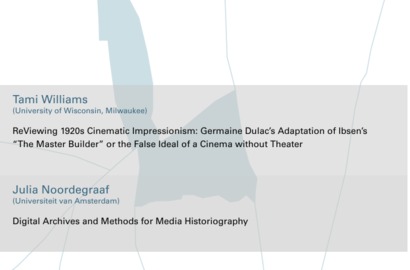Julia Noordegraaf about
Digital Archives and Methods for Media Historiography
Over the past two decades, academic and cultural heritage
institutions have made significant progress in the digitization of
audiovisual media content and related materials, such as archival
records, newspapers and program guides. In correspondence to these
digitization efforts, media scholars have increasingly adopted software
available for the creation of databases with structured data on various
aspects of the production, distribution and reception contexts. And
finally, various new tools have been developed for exploring these new,
digital collections and analyzing the data contained in them, such as
tools for text mining, image analysis, geographical mapping or network
visualization (Ross et al. 2009; Acland and Hoyt 2016). In combination,
these advances enable the development of new forms of analysis, which
were very difficult in the past, such as exploring large audiovisual
collections for historical trends in genre and visual idiom, or tracing
evolving political and cultural narratives in such collections across
different media and over longer periods of time. At the same time,
during their digitization and subsequent processing in computational
tools for search, analysis and visualization, analogue sources are
transformed in ways that influence their status as sources of knowledge
and that require new forms of literacy to assess the impact of these
transformations on interpreting them.
This lecture focuses on the epistemological and methodological consequences of working with digitized archival sources
and digital tools in media historical research. It is based on ongoing
research in the field of digital media historiography and recent
experiences with building the CLARIAH Media Suite, part of the Dutch
national infrastructure for digital humanities research. Such a
reflection starts at the archive: the context in which these sources
have been collected, preserved, organized and made accessible. How do
media objects transform with digitization, what information is lost,
what is added? Second, I focus on the interfaces that provide access to
digitized archival collections, analyzing the ways in which they allow
researchers to assess the archival processing of the underlying
material. Finally, I reflect on the new methods needed to work with
these digitized collections in the practice of media historical
research.
Julia Noordegraaf is professor of Digital
Heritage in the department of Media Studies at the University of
Amsterdam. She is director of the Amsterdam Centre for Cultural Heritage
and Identity (ACHI), one of the university’s research priority areas,
where she leads the digital humanities research program Creative
Amsterdam (CREATE) that studies the history of urban creativity using
digital data and methods. Noordegraaf’s research focuses on the
preservation and reuse of audiovisual and digital heritage.
She
has published, amongst others, the monograph Strategies of Display
(2004/2012) and, as principal editor, Preserving and Exhibiting Media
Art (2013) and acts as principal editor of the Cinema Context database
on Dutch film culture. She currently leads research projects on the
conservation of digital art (in the Horizon 2020 Marie Curie ITN project
NACCA) and on the reuse of digital heritage in data-driven historical
research (besides CREATE in the Amsterdam Data Science Research project
Perspectives on Data Quality and the new, NWO funded project Virtual
Interiors as Interfaces for Big Historical Data Research). She is a
former fellow of the Netherlands Institute for Advanced Study in the
Humanities and Social Sciences and acts as board member for Media
Studies in CLARIAH, the national infrastructure for digital humanities
research, funded by the Netherlands Organization for Scientific
Research, NWO. Noordegraaf currently coordinates the realization of the
Amsterdam Time Machine and participates as Steering Committee member in
the European Time Machine project that aims to build a simulator for
5.000 years of European history.
Venue: Casino, Raum 1.811
Campus Westend, Goethe-Universität Frankfurt am Main
All Lectures are online here
In
Kooperation mit dem BMBF-Projekt „Die universitäre Sammlung als
lebendes Archiv –
Lehre und Forschung im Spannungsfeld von Materialität
und Medialität“





